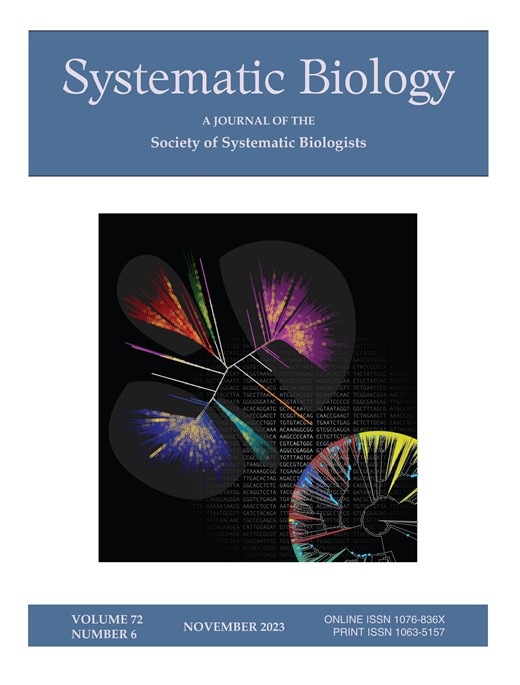Practical Guide and Review of Fossil Tip-Dating in Phylogenetics.
IF 5.7
1区 生物学
Q1 EVOLUTIONARY BIOLOGY
引用次数: 0
Abstract
Phylogenetic tip-dating has been and still is revolutionizing evolutionary biology in several ways. Fossil tip-dating, where fossils are placed into a phylogeny as tips based on morphological and/or molecular character information, provides a more principled approach to infer time-calibrated phylogenies compared with node-dating. Additionally, phylogenetic trees with fossils as tips become more and more important to elucidate evolutionary processes in macroevolutionary studies, e.g., deciphering diversification patterns and directional phenotypic evolution. Fossil tip-dating is slowly gathering popularity in empirical applications and has progressed substantially since its first demonstration in 2011, with respect to improved statistical models, software and datasets. Nevertheless, executing a phylogenetic fossil tip-dating analysis is complicated and comes with many challenges. Here, we provide an extensive review and overview of methods and models for phylogenetic tip-dating analyses with fossils. We focus both on data collection and preparation as well as on modeling choices. We start with a survey of all published phylogenetic tip-dating studies to date, showing common data and modeling choices as well as trends towards new approaches. Then, we walk readers through sections of molecular evolution, morphological evolution (both for discrete and continuous data), and lineage evolution (the fossilized-birth-death process). In each section, we describe the data and standard models with their underlying assumptions, and provide an outlook and practical recommendations.系统发育中化石尖端测年的实用指南与综述。
系统发育尖端测年已经并仍在以多种方式革新进化生物学。化石尖端定年法是将化石作为基于形态和/或分子特征信息的尖端放入系统发生中,与节点定年法相比,它提供了一种更有原则的方法来推断时间校准的系统发生。此外,在宏观进化研究中,以化石为尖端的系统发育树在解释进化过程中变得越来越重要,例如破译多样化模式和定向表型进化。化石尖端测年在实证应用中逐渐普及,自2011年首次展示以来,在改进的统计模型、软件和数据集方面取得了实质性进展。然而,执行系统发育化石尖端年代分析是复杂的,并且面临许多挑战。在这里,我们提供了广泛的回顾和概述的方法和模型的系统发育尖端年代分析与化石。我们既关注数据收集和准备,也关注建模选择。我们首先对迄今为止发表的所有系统发育尖端测年研究进行了调查,展示了常见的数据和建模选择以及新方法的趋势。然后,我们带领读者浏览分子进化,形态进化(离散和连续数据)和谱系进化(化石出生-死亡过程)的章节。在每个部分中,我们将描述数据和标准模型及其基本假设,并提供展望和实用建议。
本文章由计算机程序翻译,如有差异,请以英文原文为准。
求助全文
约1分钟内获得全文
求助全文
来源期刊

Systematic Biology
生物-进化生物学
CiteScore
13.00
自引率
7.70%
发文量
70
审稿时长
6-12 weeks
期刊介绍:
Systematic Biology is the bimonthly journal of the Society of Systematic Biologists. Papers for the journal are original contributions to the theory, principles, and methods of systematics as well as phylogeny, evolution, morphology, biogeography, paleontology, genetics, and the classification of all living things. A Points of View section offers a forum for discussion, while book reviews and announcements of general interest are also featured.
 求助内容:
求助内容: 应助结果提醒方式:
应助结果提醒方式:


